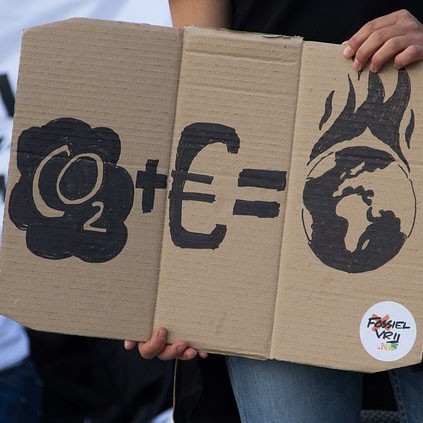
By Elke Weesjes
As the 2015 UN Climate Summit in Paris (COP21) drew to a close on December 12, delegates from 44 low-lying coastal and island countries began to sing Bob Marley’s famous refrain “Everything’s gonna be alright.” That might seem quite optimistic considering that the COP21 agreement has been widely criticized as inadequate and scientists have warned that the pact won’t avoid dangerous climate change. Still, for participating countries—especially those most at risk from climate change—the agreement marks a diplomatic victory if not a scientific one.
The opposing views stem from expectations nations had going into the conference, wrote ethics professor Clive Hamilton in The Conversation. The COP21 agreement might not be as effective or binding as some might like, but the pact between the 195 countries is likely the best that could have been hoped for, Hamilton argued.
All the countries, without exception, pledged to set emission targets. They also acknowledged that developed countries should not only assist their developing counterparts in meeting the targets, but also help them adapt to the effects of climate change. Finally—and perhaps the biggest achievement of all—the pact required the parties to pledge that they would keep global temperature rise “well below two degrees Celsius (3.6 degrees Fahrenheit) above preindustrial levels while pursuing efforts to limit the temperature increase to 1.5 degrees Celsius (2.7 degrees Fahrenheit).”
The 1.5-degree cap was a particular win for the Alliance of Small Island States (AOSIS) and other vulnerable nations, which maintained that the two-degree goal would be insufficient to save countries on the frontlines of climate change, such as Vietnam, Bangladesh, the Maldives, Tuvalu, and the Marshall Islands.
“Our members are particularly vulnerable to climate extremes and climate change impacts and we are acutely aware of the vanishingly little time remaining to adopt a legally binding climate treaty,” Thoriq Ibrahim, chairman of AOSIS and the environment and energy minister of the Maldives told The Guardian on the first day of the Conference.
The legally binding aspect of the agreement is one area that wasn’t achieved. For example, the provision of financial support for developing nations is not a binding commitment, but an intention of mobilization. The agreement only stipulates that a new target of at least $100 billion per year in international climate aid must be formulated by 2025. Though laudable in concept, a decade might as well be a lifetime away for nations that are literally struggling to keep their heads above water.
The intention of the countries to lower emissions—vaguely described as “nationally determined contributions”—are also non-binding. But the most glaring flaw in the agreement, according to critics, is the fact that even if countries do keep their commitments to lower emissions, it won’t be nearly enough to deliver the two-degree target, let alone the more ambitious 1.5 degree one. Three degrees is more likely.
That didn’t keep Olai Uludong, AOSIS lead COP21 negotiator, from being hopeful. Aware that some of the achievements of the agreement—especially the 1.5-degree goal—are perhaps more symbolic than realistic, Uludong focused on the new diplomatic precedent that had been established.
“In Paris, we achieved what I think of as yellow-bus diplomacy,” Uludong told The New Yorker. “Envision one of those yellow buses in India where you have people hanging out of the windows—that’s how I see this agreement. Maybe the G20 are sitting on the seats, but the rest of us are there, holding onto the sides and the back.”
In the end, Hamilton points out, we must be aware of the realities of science, but like Uludong, he also champions the diplomatic headway made. “If we allow ourselves to be drawn over to the everything-will-be-OK pole, we are ignoring the science and indulging in wishful thinking,” he wrote. “If we allow ourselves to be drawn over to the catastrophe pole, which is quite consistent with the science, then we become unable to recognize and encourage the positive steps that are being made. Three degrees is a big improvement on four, and 2.5°C is even better, even if it remains bad. But what matters most is momentum.”
Elke Weesjes Sabella is former editor of the Natural Hazards Observer. She joined the staff in December 2014 after a brief stint as a correspondent for a United Nations nonprofit. Under her leadership, the Observer was revamped to a more visual format and one that included national and international perspectives on threats facing the world. Weesjes was the editor of the peer-reviewed bimonthly publication United Academics Journal of Social Sciences from 2010 to 2013.
Weesjes Sabella also worked as a research associate for the Center for Disaster and Risk Analysis, formerly located at Colorado State University (although no longer active). In that role, she collected and analyzed data and translated research findings for a broader audience. She played a central role in finalizing the Disaster Preparedness among Childcare Providers in Colorado project, which examines all-hazards preparedness in daycares and in-home childcare across Colorado. She co-authored the report based on the first stage of the project, which was funded by Region VIII of the Federal Emergency Management Agency.
Weesjes Sabella specializes in cultural memory and neighborhood/community change in times of acute and chronic stress. She has published articles on the impact of drought on farming communities in Kansas, the effects of Superstorm Sandy in Far Rockaway, Queens, urban renewal in the Bedford-Stuyvesant neighborhood in Brooklyn, and health services for vulnerable populations in the South Bronx.
Weesjes Sabella received her PhD from the University of Sussex. Her dissertation, Children of the Red Flag: Growing up in a Communist Family During the Cold War (2012), as well as the majority of her publication record, share the common methodology of understanding culture and identity through oral history.